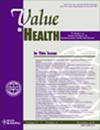The Cost-Effectiveness of Seizure Dogs for Persons Living With Severe Refractory Epilepsy: Results From the EPISODE Study
IF 4.9
2区 医学
Q1 ECONOMICS
引用次数: 0
Abstract
Objectives
The Epilepsy Support Dog Evaluation study was commissioned by the Dutch Ministry of Health, Welfare and Sports to inform a reimbursement decision on seizure dogs. The randomized trial found that seizure dogs reduce seizure frequency and improve health-related quality of life of persons with severe refractory epilepsy (PSREs). This article examined the cost-effectiveness (CE) of adding seizure dogs to usual care for PSREs in The Netherlands.
Methods
A microsimulation model was developed, informed by generalized linear mixed models using patient-level trial data from the Epilepsy Support Dog Evaluation study. The model adopted a 10-year time horizon and took a societal perspective. Seizure frequency was predicted as a function of time with the seizure dog. Patient utilities, caregiver utilities, and costs were predicted as a function of seizure frequency and time with the seizure dog.
Results
Quality-adjusted life-years (QALYs) of PSREs with a seizure dog and usual care alone were estimated at 6.28 and 5.65, respectively (Δ 0.63). For caregivers, estimated QALYs were 6.94 and 6.52, respectively (Δ 0.42). Total costs were respectively €228 691 and €226 261 (Δ €2430). Intervention costs were largely offset by savings in informal care and healthcare. The incremental CE ratio was €2314/QALY. Probabilistic sensitivity analysis indicated a 91% probability of seizure dogs being cost-effective at the €50 000/QALY threshold. The incremental CE ratio fell well below this threshold in scenario analyses.
Conclusions
Seizure dogs are likely to be a cost-effective addition to usual care for PSREs in The Netherlands.
严重难治性癫痫患者使用癫痫犬的成本效益:EPISODE 研究的结果。
研究目的EPISODE 研究由荷兰卫生、福利和体育部委托进行,旨在为癫痫发作犬的报销决定提供参考。随机试验发现,癫痫发作犬可降低严重难治性癫痫患者(PSREs)的癫痫发作频率,并改善其与健康相关的生活质量。本文探讨了在荷兰为 PSREs 患者提供常规护理的基础上添加癫痫犬的成本效益:方法:利用 EPISODE 研究中患者层面的试验数据,通过广义线性混合模型建立了一个微观模拟模型。该模型的时间跨度为 10 年,并采用了社会视角。癫痫发作频率是通过使用癫痫发作犬的时间来预测的。患者的效用、护理人员的效用和成本则作为癫痫发作频率和使用癫痫犬时间的函数进行预测:使用癫痫犬进行 PSRE 和仅使用常规护理的质量调整生命年 (QALY) 估计分别为 6.28 和 5.65(Δ 0.63)。对于护理人员,估计的QALY分别为6.94和6.52(Δ 0.42)。总成本分别为 228,691 欧元和 226,261 欧元(Δ 2,430 欧元)。干预成本在很大程度上被非正式护理和医疗保健方面节省的费用所抵消。增量成本效益比(ICER)为 2314 欧元/QALY。概率敏感性分析表明,在 50,000 欧元/QALY 临界值时,癫痫犬具有成本效益的概率为 91%。在情景分析中,ICER 远远低于这一阈值:在荷兰,癫痫犬很可能是对 PSRE 常规护理的一种具有成本效益的补充。
本文章由计算机程序翻译,如有差异,请以英文原文为准。
求助全文
约1分钟内获得全文
求助全文
来源期刊

Value in Health
医学-卫生保健
CiteScore
6.90
自引率
6.70%
发文量
3064
审稿时长
3-8 weeks
期刊介绍:
Value in Health contains original research articles for pharmacoeconomics, health economics, and outcomes research (clinical, economic, and patient-reported outcomes/preference-based research), as well as conceptual and health policy articles that provide valuable information for health care decision-makers as well as the research community. As the official journal of ISPOR, Value in Health provides a forum for researchers, as well as health care decision-makers to translate outcomes research into health care decisions.
 求助内容:
求助内容: 应助结果提醒方式:
应助结果提醒方式:


